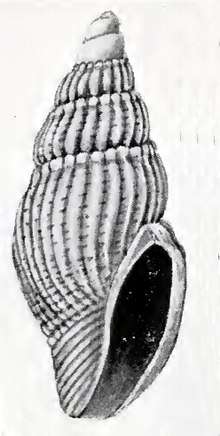Mitromorpha multicostata
Mitromorpha multicostata is a species of sea snail, a marine gastropod mollusk in the family Mitromorphidae.[1]
| Mitromorpha multicostata | |
|---|---|
 | |
| Original image of a shell of Mitromorpha multicostata | |
| Scientific classification | |
| Kingdom: | Animalia |
| Phylum: | Mollusca |
| Class: | Gastropoda |
| Clade: | Caenogastropoda |
| Clade: | Hypsogastropoda |
| Clade: | Neogastropoda |
| Superfamily: | Conoidea |
| Family: | Mitromorphidae |
| Genus: | Mitromorpha |
| Species: | M. multicostata |
| Binomial name | |
| Mitromorpha multicostata May, 1911 | |
| Synonyms[1] | |
| |
Description
The length of the shell attains 4.3 mm, its diameter 2 mm.
(Original description) The solid, yellowish shell has an elongate oval shape. It contains five whorls, including a pointed protoconch of two smooth whorls. The spire whorls are convex. The suture is well impressed. The base of the shell is contracted. The aperture is elongate oval, not constricted into a siphonal canal. The outer lip is simple and convex in outline. The columella is slightly curved. The shell shows numerous straight rounded axial ribs that extend across the whorls, and over about two-thirds of the body whorl there are about 24 on the penultimate whorl. They are separated by deep grooves, which are narrower than the ribs. There is one distinct spiral groove or depression below the suture. Numerous faint spirals, which can scarcely be seen without a lens, cross the shell, and are most conspicuous in the grooves. They become much stronger on the base.[2]
Distribution
This marine species is endemic to Australia and occurs off Tasmania.
References
- Hedley, C. 1922. A revision of the Australian Turridae. Records of the Australian Museum 13(6): 213–359, pls 42–56
External links
- Tucker, J.K. (2004). "Catalog of recent and fossil turrids (Mollusca: Gastropoda)" (PDF). Zootaxa. 682: 1–1295.